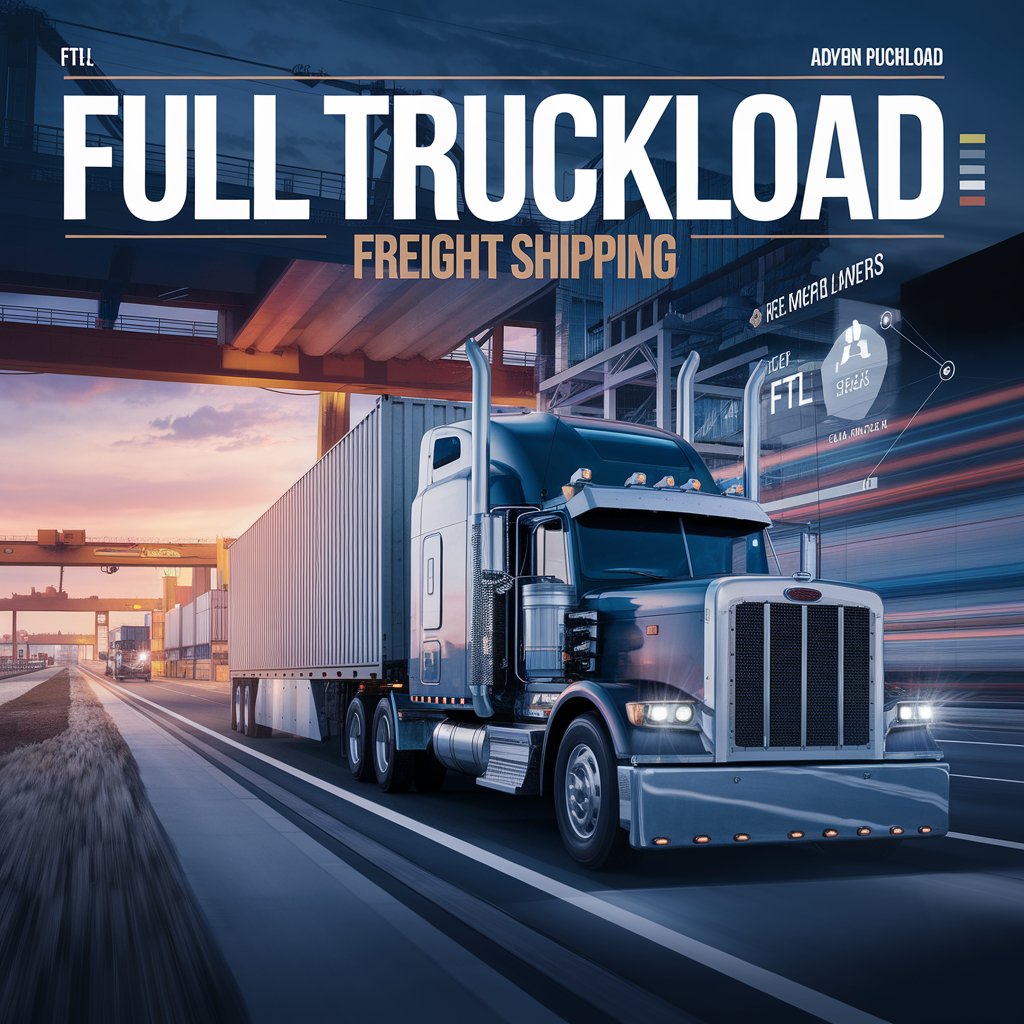Full Truckload Freight: Mastering FTL Shipments and Load Planning

Key Takeaways:
- Full truckload freight utilizes the entire capacity of a truck for one shipment
- Effective load planning is crucial for FTL efficiency and safety
- FTL shipments come in various types, each with unique requirements
- Technology plays a significant role in modern FTL shipment management
- Proper documentation and handling of exceptions are vital in FTL shipping
Understanding Full Truckload Freight and Its Characteristics
Full truckload freight is characterized by several key features:
- Dedicated Capacity: The entire truck is used for one shipper’s goods.
- Direct Transit: Shipments typically move directly from origin to destination.
- Faster Delivery: With no intermediate stops, FTL often provides quicker transit times.
- Reduced Handling: Less handling of goods minimizes the risk of damage.
- Cost-Effective for Large Shipments: More economical than LTL for larger volumes.
- Flexible Scheduling: Allows for more control over pickup and delivery times.
- Suitable for Various Cargo Types: Can accommodate different types of freight, from palletized goods to oversized items.
Understanding these characteristics helps shippers determine when full truckload freight is the most appropriate shipping method for their needs.
Types of FTL Shipments and Their Specific Requirements
Full truckload freight encompasses various types of shipments, each with its own requirements:
- Dry Van FTL:
- Most common type
- For non-perishable, packaged goods
- Requires standard loading equipment like forklifts
- Refrigerated (Reefer) FTL:
- For temperature-sensitive goods
- Requires temperature monitoring and control
- Needs proper insulation and cooling equipment
- Flatbed FTL:
- For oversized or oddly shaped items
- Requires special loading and securing equipment
- Often needs permits for oversize loads
- Tanker FTL:
- For liquid or gas transportation
- Requires specialized handling and safety precautions
- Needs proper cleaning between loads
- Intermodal FTL:
- Combines truck transport with other modes (e.g., rail)
- Requires standardized containers
- Needs coordination between different transportation modes
- Hazardous Materials FTL:
- For transporting dangerous goods
- Requires special certifications and handling procedures
- Needs proper labeling and documentation
- Expedited FTL:
- For time-sensitive shipments
- Often involves team drivers for non-stop transit
- Requires careful scheduling and route planning
Each type of FTL shipment requires specific handling, equipment, and expertise to ensure safe and efficient transportation.
- Full truckload freight utilizes the entire capacity of a truck for one shipment
- Effective load planning is crucial for FTL efficiency and safety
- FTL shipments come in various types, each with unique requirements
- Technology plays a significant role in modern FTL shipment management
- Proper documentation and handling of exceptions are vital in FTL shipping
- Full truckload freight utilizes the entire capacity of a truck for one shipment
- Effective load planning is crucial for FTL efficiency and safety
- FTL shipments come in various types, each with unique requirements
- Technology plays a significant role in modern FTL shipment management
- Proper documentation and handling of exceptions are vital in FTL shipping
Load Planning and Optimization for FTL Shipments
Effective load planning is crucial for maximizing the efficiency and safety of full truckload freight:
- Weight Distribution:
- Ensure even weight distribution across the trailer
- Place heavier items towards the front of the trailer
- Stay within legal weight limits for axles and gross vehicle weight
- Space Utilization:
- Maximize use of vertical space
- Use appropriate stacking techniques
- Consider using load bars or straps for stability
- Product Compatibility:
- Group similar products together
- Separate items that could contaminate each other
- Consider temperature requirements for mixed loads
- Loading Sequence:
- Plan for the most efficient unloading process
- Consider multiple stops in the loading order
- Use last-in-first-out (LIFO) principle for multi-stop routes
- Securing the Load:
- Use appropriate tie-downs, straps, or load locks
- Ensure compliance with cargo securement regulations
- Prevent load shifting during transit
- Optimization Software:
- Utilize load planning software for complex shipments
- Consider factors like dimensions, weight, and handling requirements
- Use 3D visualization tools for better space utilization
- Continuous Improvement:
- Analyze past shipments for efficiency improvements
- Gather feedback from drivers and receivers
- Stay updated on new load planning techniques and technologies
Proper load planning ensures safe transit, prevents damage to goods, and maximizes the cost-effectiveness of full truckload freight.

Maximizing Efficiency: How to Fully Utilize Truck Capacity
To make the most of full truckload freight, consider these strategies for maximizing truck capacity:
- Proper Packaging: Use efficient packaging to reduce wasted space.
- Mixed Palletization: Combine different products on a single pallet when appropriate.
- Vertical Space Utilization: Use stackable containers or double-stacking when safe.
- Customized Packaging: Design packaging that fits well in standard truck dimensions.
- Flexible Delivery Windows: Allow for consolidation of shipments to fill trucks.
- Regular Shipping Schedules: Establish consistent shipping patterns for better planning.
- Collaboration with Other Shippers: Partner with companies shipping to similar destinations.
By implementing these strategies, shippers can significantly improve the efficiency and cost-effectiveness of their full truckload freight shipments.
FTL Shipment Documentation and Paperwork
Proper documentation is crucial for smooth full truckload freight operations:
- Bill of Lading (BOL):
- Serves as a receipt and contract between shipper and carrier
- Includes details like shipment content, origin, destination, and special instructions
- Commercial Invoice:
- Required for international shipments
- Details the value and description of goods
- Packing List:
- Itemized list of package contents
- Useful for verifying shipment completeness
- Proof of Delivery (POD):
- Confirms successful delivery of the shipment
- Often includes recipient’s signature
- Customs Documentation:
- Necessary for international FTL shipments
- May include forms like customs declarations and certificates of origin
- Hazardous Materials Documentation:
- Required for shipments containing dangerous goods
- Includes safety data sheets and proper classification
- Electronic Logging Device (ELD) Records:
- Digital records of driver hours and vehicle operation
- Required by law in many jurisdictions
Ensuring all documentation is accurate and complete is essential for compliance and efficient full truckload freight operations.
Handling Speciality FTL Loads
Some full truckload freight requires special handling:
- Oversized Loads:
- May require special permits and escort vehicles
- Need careful route planning to avoid obstacles
- Fragile Goods:
- Require extra padding and secure bracing
- May need specialized shock-absorbing equipment
- Perishable Items:
- Demand precise temperature control
- Require careful monitoring throughout transit
- High-Value Cargo:
- May need additional security measures
- Often requires specialized insurance coverage
- Hazardous Materials:
- Must comply with strict regulations
- Require specially trained drivers and equipment
- Live Animals:
- Need proper ventilation and care during transit
- Require stops for feeding and watering
- Pharmaceuticals:
- Demand strict temperature control and security
- May require specialized documentation and handling procedures
Each type of specialty load in full truckload freight shipping requires specific expertise and equipment to ensure safe and compliant transportation.
FTL Shipment Tracking and Visibility Solutions
Modern full truckload freight relies heavily on advanced tracking and visibility solutions:
- GPS Tracking:
- Provides real-time location updates
- Enables accurate ETAs and route optimization
- IoT Sensors:
- Monitor conditions like temperature and humidity
- Alert to any issues during transit
- Electronic Logging Devices (ELDs):
- Track driver hours and vehicle operation
- Ensure compliance with hours-of-service regulations
- Mobile Apps:
- Allow drivers to update status and report issues
- Provide real-time communication between drivers and dispatchers
- Customer Portals:
- Give shippers and receivers access to shipment information
- Enable self-service tracking and documentation retrieval
- Predictive Analytics:
- Use historical data to predict potential delays or issues
- Help in proactive problem-solving
- Blockchain Technology:
- Enhances security and transparency of shipment data
- Improves traceability throughout the supply chain
These technologies significantly enhance the efficiency and reliability of full truckload freight shipments.
Managing Exceptions and Issues in FTL Shipments
Even with careful planning, issues can arise in full truckload freight. Here’s how to manage common exceptions:
- Delays:
- Communicate promptly with all parties
- Adjust schedules and notify downstream supply chain partners
- Route Changes:
- Use real-time traffic data for re-routing
- Ensure new routes comply with any restrictions (e.g., for hazmat loads)
- Equipment Breakdowns:
- Have a network of repair services along common routes
- Implement preventive maintenance schedules
- Cargo Damage:
- Document damage thoroughly
- Have clear procedures for claims and resolution
- Weather Issues:
- Monitor weather forecasts and plan accordingly
- Have contingency plans for severe weather events
- Customs Delays:
- Ensure all documentation is in order before shipping
- Work with experienced customs brokers for international shipments
- Refused Shipments:
- Have clear procedures for handling and returning refused goods
- Communicate quickly with the shipper for resolution
Effective exception management is key to maintaining reliability in full truckload freight operations.
Intermodal Options for FTL Freight
Intermodal transportation can be an efficient option for some full truckload freight:
- Truck-Rail Intermodal:
- Combines the flexibility of trucking with the efficiency of rail
- Ideal for long-distance domestic shipments
- Truck-Sea Intermodal:
- Uses containerized shipping for international FTL freight
- Requires coordination between trucking and ocean carriers
- Truck-Air Intermodal:
- For time-sensitive or high-value full truckload freight
- Combines trucking for local transport with air for long-distance
- Benefits of Intermodal FTL:
- Can be more cost-effective for long distances
- Often more environmentally friendly than truck-only transport
- Challenges in Intermodal FTL:
- Requires careful coordination between different modes
- May have longer transit times due to mode transfers
- Equipment for Intermodal FTL:
- Uses standardized containers for easy transfer between modes
- Requires specialized chassis for truck transport of containers
- Technology in Intermodal FTL:
- Uses advanced tracking systems for visibility across modes
- Relies on sophisticated scheduling software for efficient transfers
Intermodal options can provide cost and environmental benefits for suitable full truckload freight shipments.
Seasonal Variations in FTL Shipments and How to Prepare
Full truckload freight volumes often fluctuate seasonally:
- Peak Seasons:
- Identify industry-specific peak periods (e.g., holiday retail, harvest for agriculture)
- Secure capacity early for high-demand periods
- Off-Peak Planning:
- Negotiate better rates during slower periods
- Consider shifting non-urgent shipments to off-peak times
- Weather Considerations:
- Plan for potential weather-related disruptions in winter
- Ensure temperature-controlled equipment is available for summer shipments
- Capacity Management:
- Build relationships with multiple carriers to ensure availability
- Consider dedicated fleet options for consistent high-volume periods
- Inventory Planning:
- Adjust inventory levels to accommodate seasonal demand fluctuations
- Use data analytics to predict seasonal needs accurately
- Staff Training:
- Ensure staff is prepared for peak season demands
- Cross-train employees to handle various aspects of FTL shipping
- Technology Utilization:
- Use forecasting tools to predict seasonal volume changes
- Implement load optimization software to maximize efficiency during peak times
Proper preparation for seasonal variations can help maintain efficiency and cost-effectiveness in full truckload freight operations throughout the year.

Best Practices for Loading and Unloading FTL Shipments
Efficient loading and unloading are crucial for full truckload freight operations:
- Pre-Loading Planning:
- Prepare a detailed loading plan before the truck arrives
- Ensure all necessary equipment (forklifts, pallet jacks) is ready
- Proper Sequencing:
- Load in reverse order of delivery for multi-stop routes
- Group similar items together for easier unloading
- Weight Distribution:
- Distribute weight evenly across the trailer
- Adhere to axle weight limits
- Secure Packaging:
- Use appropriate packaging materials to prevent damage
- Ensure pallets are in good condition and properly wrapped
- Efficient Use of Space:
- Maximize vertical space usage
- Use load bars or air bags to fill gaps and prevent shifting
- Safety Measures:
- Train staff in proper lifting techniques
- Ensure loading docks are well-maintained and safe
- Documentation:
- Verify shipment contents against the bill of lading during loading/unloading
- Document any discrepancies or damages immediately
Implementing these best practices can significantly improve the efficiency and safety of full truckload freight operations.
The Impact of E-commerce on FTL Shipment Patterns
E-commerce has significantly influenced full truckload freight patterns:
- Increased Demand:
- Growth in online shopping has led to higher overall FTL volumes
- Seasonal peaks (like holiday shopping) have become more pronounced
- Faster Delivery Expectations:
- Pressure for quicker transit times in FTL shipments
- Need for more efficient route planning and load optimization
- Diverse Product Mix:
- FTL shipments now often contain a wider variety of products
- Requires more complex load planning and handling
- Reverse Logistics:
- Increased returns have led to more FTL shipments for reverse logistics
- Need for specialized handling and processing of returned goods
- Warehouse Network Changes:
- Shift towards more, smaller warehouses closer to urban centers
- Changes in typical FTL routes and distances
- Technology Integration:
- Greater need for real-time tracking and visibility in FTL shipments
- Integration of e-commerce platforms with transportation management systems
- Last-Mile Coordination:
- FTL shipments increasingly need to coordinate with last-mile delivery services
- Requires more flexible scheduling and drop-off procedures
Understanding and adapting to these e-commerce-driven changes is crucial for success in modern full truckload freight operations.

Technology Tools for Better FTL Shipment Management
Advanced technology tools are revolutionizing full truckload freight management:
- Transportation Management Systems (TMS):
- Centralize shipping operations management
- Optimize route planning and carrier selection
- Load Planning Software:
- Maximize trailer space utilization
- Ensure proper weight distribution and load stability
- Real-Time Tracking Platforms:
- Provide visibility into shipment location and status
- Enable proactive issue resolution
- Predictive Analytics:
- Forecast shipping demand and potential disruptions
- Optimize pricing and capacity planning
- Mobile Apps for Drivers:
- Facilitate communication between drivers and dispatchers
- Enable electronic documentation and proof of delivery
- Internet of Things (IoT) Sensors:
- Monitor cargo conditions (temperature, humidity, shock)
- Alert to potential issues in real-time
- Artificial Intelligence and Machine Learning:
- Optimize routing and scheduling
- Predict maintenance needs and potential delays
- Blockchain Technology:
- Enhance transparency and security in documentation
- Streamline payments and contracts
- Digital Freight Matching Platforms:
- Connect shippers with available carriers in real-time
- Reduce empty miles and improve capacity utilization
- Yard Management Systems:
- Optimize trailer positioning and loading/unloading schedules
- Improve overall efficiency of distribution centers
These technological advancements are transforming full truckload freight management, leading to increased efficiency, reduced costs, and improved customer satisfaction.

Case Studies: Successful Handling of Complex FTL Shipments
Examining real-world examples provides valuable insights into effective full truckload freight management:
- Walmart’s Precision Scheduling:
- Challenge: Managing a vast network of FTL shipments to thousands of stores.
- Solution: Implemented advanced scheduling software to optimize truck routes and loading times.
- Result: Reduced empty miles by 20% and improved on-time delivery rates.
- Procter & Gamble’s Load Optimization:
- Challenge: Maximizing trailer utilization for diverse product lines.
- Solution: Adopted 3D load planning software to optimize cargo arrangement.
- Result: Increased trailer fill rates by 15% and reduced transportation costs.
- Amazon’s Dynamic Routing:
- Challenge: Meeting rapid delivery promises while managing FTL costs.
- Solution: Developed AI-driven routing algorithms for real-time optimization.
- Result: Improved delivery speed by 10% and reduced fuel costs.
- DHL’s Temperature-Controlled Pharma Shipments:
- Challenge: Ensuring integrity of sensitive pharmaceutical FTL shipments.
- Solution: Implemented IoT sensors for real-time temperature monitoring and alerts.
- Result: Achieved 99.9% compliance with temperature requirements and reduced product loss.
- Home Depot’s Hurricane Response:
- Challenge: Rapidly repositioning FTL shipments during natural disasters.
- Solution: Created a flexible logistics network with real-time inventory visibility.
- Result: Successfully pre-positioned critical supplies ahead of hurricanes, supporting community relief efforts.
These case studies demonstrate how innovative approaches to full truckload freight management can overcome complex challenges and deliver significant benefits.
Conclusion: The Future of Full Truckload Freight
As we’ve explored throughout this article, full truckload freight is a complex and dynamic field, crucial to the global supply chain. From understanding the basics of FTL shipments to mastering advanced load planning techniques, from leveraging cutting-edge technology to navigating seasonal variations, success in FTL shipping requires a multifaceted approach.
Key takeaways for mastering full truckload freight include:
- Embrace Technology: From TMS to IoT sensors, technology is transforming FTL operations.
- Optimize Load Planning: Efficient loading is crucial for cost-effectiveness and safety.
- Adapt to Market Changes: E-commerce and other trends are reshaping FTL shipment patterns.
- Prioritize Visibility: Real-time tracking and proactive communication are essential.
- Manage Exceptions Effectively: Be prepared to handle delays, route changes, and other issues.
- Consider Intermodal Options: For some shipments, combining modes can offer benefits.
- Stay Compliant: Understand and adhere to regulations and proper documentation practices.
Looking ahead, the future of full truckload freight is likely to be shaped by continued technological advancements, increasing focus on sustainability, and evolving customer expectations. Autonomous vehicles, alternative fuels, and even more sophisticated AI-driven logistics systems are on the horizon.
For shippers, carriers, and logistics professionals, staying informed about these developments and continuously adapting practices will be key to success. By mastering the fundamentals of FTL shipments and load planning, while remaining open to innovation, businesses can ensure they’re well-positioned to meet the challenges and opportunities of tomorrow’s freight landscape.
In an increasingly connected and fast-paced world, efficient and reliable full truckload freight will continue to play a vital role in keeping the global economy moving. Those who can navigate its complexities with skill and adaptability will find themselves at the forefront of this essential industry.
